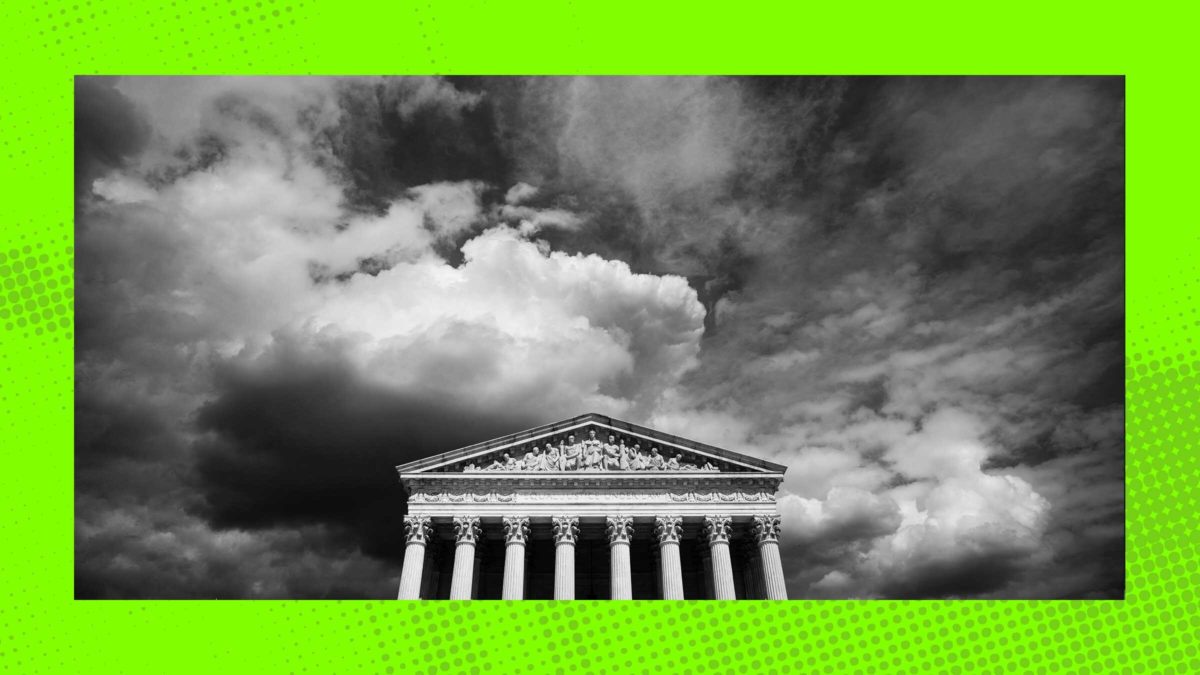Editor’s note: This month, we’ll be taking a closer look at some of the most consequential cases the Supreme Court—the most conservative Supreme Court in a century—will decide in its upcoming term. Today: Students For Fair Admissions v. University of North Carolina and Students For Fair Admissions v. President & Fellows of Harvard College, a pair of cases that together accomplish the impossible: making you want to take sides in a dispute with Harvard.
Next term, the Court will hear two legal challenges to the affirmative action programs used by the admissions offices at the University of North Carolina and Harvard College. The petitioner in these cases, an anodyne-sounding but deceptively-named organization called the Students For Fair Admissions, is claiming that affirmative action hurts Asian-American students, and is asking the Court to prevent colleges and universities from considering students’ race in the admissions process ever again.
Students For Fair Admissions is the brainchild of Edward Blum, a white former stockbroker who has brought dozens of lawsuits attacking various laws designed to correct for legacies of discrimination against people of color: affirmative action programs, majority-minority legislative districts, and the Voting Rights Act itself. SFA’s esteemed leadership includes Abigail Fisher, the white woman who unsuccessfully challenged affirmative action in Fisher v. University of Texas, the Supreme Court’s last big case on the subject, in 2016. SFA’s leadership also includes Abigail’s father; Blum and the Fishers met after he told a mutual acquaintance that he was looking for a white woman to challenge his alma mater’s affirmative action program. Fisher, indignant about her recent rejection, was happy to help.
Although he failed in Fisher, Blum has since opted for a different route to try and put the final nail in affirmative action’s coffin. In a 2018 lecture hosted by the Houston Chinese Alliance, Blum recalled the moment of his strategic epiphany. “How do we go about making it impossible for universities to use race and ethnicity?” he asked. “I needed Asian plaintiffs.” Thus began his twin fights against Harvard College and the University of North Carolina—one private institution, one public—which allege that by considering the race of students in the admissions process, colleges and universities violate federal civil rights laws and the Equal Protection Clause of the 14th Amendment.
The Equal Protection Clause wasn’t always used as a vehicle for cynical attacks on policies that benefit people of color. When the Supreme Court outlawed public school segregation in 1954’s Brown v. Board of Education, for example, it placed great weight on the ways segregation perpetuates the harms of racism. “To separate [children of color] from others of similar age and qualifications solely because of their race generates a feeling of inferiority as to their status in the community that may affect their hearts and minds in a way unlikely ever to be undone,” a unanimous Court wrote.

This is a picture of Ed Blum, NOT of a middle-aged accountant who is moonlighting as Patrick Bateman in a community theater production of American Psycho (Photo by Matt McClain for The Washington Post via Getty Images)
If that logic had persisted at the Court, perhaps the destruction of race-conscious affirmative action programs would not be looming today. But in 1978, the Court began centering white feelings in its analysis, especially in the context of higher education. In Regents of the University of California v. Bakke, a white man named Allan Bakke claimed that his rejection from UC Davis Medical School, which used an affirmative action program, violated the Equal Protection Clause. The Court agreed, upholding the ability of schools to consider race for the purposes of ensuring “diversity” but deeming programs that use numerical quotas unconstitutional.
In 2003, the Court in Grutter v. Bollinger affirmed the ability of schools to use race as one of many factors in admissions decisions, but with a catch: Justice Sandra Day O’Connor, who wrote for a majority of five justices, left the door open for the future judicial dismantling of affirmative action programs. “Race-conscious admissions policies must be limited in time,” she declared. “The Court expects that 25 years from now, the use of racial preferences will no longer be necessary.” In Students For Fair Admissions, Blum and company hope to accelerate this timeline by a few years.
The consequences of affirmative action’s death would be dire. In California, after a 1996 state voter initiative known as Proposition 209 outlawed race-conscious admissions in public higher education, Black and Latinx student enrollment dropped significantly, according to a 2020 study. That same study cast doubt on the logic of Blum’s argument in Students For Fair Admissions, suggesting that affirmative action programs in place before Prop 209 didn’t negatively impact white and Asian students denied admission to the most selective University of California campuses, because these individuals simply went to other elite universities. The study did find, however, that Black and Latinx students pushed out of those campuses earned lower wages after graduation.
Despite Blum’s framing, affirmative action is popular among the Asian American community: A recent survey shows that 69% of Asian American voters support “programs designed to help Black people, women, and other minorities get better access to higher education.” Eri Andriola, staff attorney at Asian Americans Advancing Justice-AAJC, which has filed an amicus brief in this litigation, explains that people like Blum and Fisher are using Asian American students as a “racial wedge” to attack affirmative action programs that these students actually benefit from. We recently spoke with Andriola to learn more about the history of challenges to affirmative action, the future of race-based preferences, and the consequences of their disappearance.
Balls & Strikes: What is at stake for the Asian American community in these cases?
Eri Andriola: Affirmative action gives all students the opportunity to share their whole stories, backgrounds and unique lived experiences on their application. Race is one of only one of the many factors that’s considered in a holistic review process, and provides important context for students’ lived experiences. And race continues to shape the lives of many students through systemic barriers to K-12 educational opportunities and instances of Anti-Asian hate. Being able to tell their full story benefits Asian Americans, especially during a time when we are seeing this rise of anti-Asian hate come to the forefront.
B&S: It’s striking how limited the use of race actually is in these admissions programs. As affirmative action jurisprudence has evolved, the justices did away with strict racial quotas in favor of a more holistic process where, as you’re saying, race is just one of many factors that are considered in someone’s admissions process.
That’s exactly right. The Supreme Court has already held that racial quotas are not permissible. Instead, admissions processes need a flexible approach regarding how admissions officers factor in race in their decisionmaking. It’s important to remember that these programs are not racial quotas, and that race is not a determining factor in any review of a student’s application.
Considering socioeconomic status alone cannot account for the unique ways in which race impacts students’ lived experiences. The lower courts have found that socioeconomic status alone cannot replace the consideration of race and is not an adequate alternative.
Our amicus brief is about students who testified at the trial court to share their experiences with the application process and their experiences at Harvard. Their testimony really illustrates how race has shaped their experiences in a unique way that isn’t accounted for in experiences related to their socioeconomic status alone—the way they experience race in the education system, and the ways in which, for example, teachers treat students that shape their educational opportunities.

The Wilson Library at UNC-Chapel Hill (Photo by Melissa Sue Gerrits/Getty Images)
What would happen if the court adopts SFA’s alternative proposals for admissions programs? What would those look like?
Without the consideration of race in admissions, we know that, in the Harvard case, the share of Black students and Latinx students would drop dramatically. From the trial record, the share of Black admitted students would decline from 14 percent to 6 percent, and the share of Latinx students would decline from 14 percent to 9 percent. We know that students experience racial isolation and hostility on campus, and such a decline in diversity leaves students open to more instances of feeling racially isolated—a lack of community. They would feel like a sort of a token, and like they have to speak for their race, for example.
It’s also a signal that universities don’t value those diverse experiences and identities that students bring forward. All students stand to benefit from a racially diverse learning environment. Studies show that students benefit in terms of cross-racial understanding, critical thinking, problem-solving, and really how to be thinkers and leaders in an increasingly multicultural world.
Clarence Thomas has spoken about tokenism to argue against affirmative action. He says that he felt like he had a red stamp on his forehead because of affirmative action, prompting assumptions that he only got into Yale Law School because of that. Why is that line of thinking so misguided?
It’s important to remember that these are exceptional students, and that all students have unique experiences that they bring to the table. There’s this misconception about how affirmative action works. Students of color benefiting from affirmative action are highly qualified students. The holistic admissions process just allows admissions officers to look at their applications in a more complete way.
Why is affirmative action so important for communities of color?
Our briefs talk about how all students benefit from this diverse learning environment, but for AAPI students in particular, there’s this “model minority” myth that sometimes obscures the diversity of our community. It is such a harmful stereotype that paints the community as a monolith. Oftentimes, the voices, perspectives and experiences of low-income, immigrant and refugee, English Language Learner students from a diverse array of ethnic backgrounds are not visible within that “model minority” category. Affirmative action, holistic review, allows those stories to be told and those perspectives to be part of the application process.
This is a “both/and” situation—affirmative action is critical for students of color, and also will benefit all students.
And not only within the classroom itself. Universities are places where students really learn to be a part of this increasingly multicultural world. And it’s really a detriment to our society as a whole if students aren’t given the opportunity to learn together.




